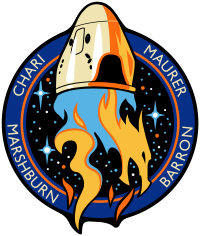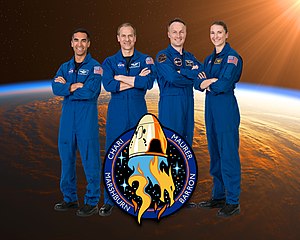 Endurance at LC-39A | |
| Names | USCV-3 |
|---|---|
| Mission type | ISS crew transport |
| Operator | SpaceX |
| COSPAR ID | 2021-103A |
| SATCAT no. | 49407 |
| Mission duration | 180 days (planned) |
| Spacecraft properties | |
| Spacecraft | Crew Dragon Endurance |
| Spacecraft type | Crew Dragon |
| Manufacturer | SpaceX |
| Launch mass | 12,519 kg (27,600 lb) |
| Landing mass | 9,616 kg (21,200 lb) |
| Crew | |
| Crew size | 4 |
| Members | |
| Expedition | Expedition 66 / 67 |
| Start of mission | |
| Launch date | 31 October 2021, 06:21 UTC (planned) [1] |
| Rocket | Falcon 9 Block 5 (B1067.2) [2] |
| Launch site | Kennedy Space Center, LC-39A |
| Contractor | SpaceX |
| End of mission | |
| Landing date | Late April 2022 (planned) |
| Landing site | Atlantic Ocean |
| Orbital parameters | |
| Reference system | Geocentric orbit |
| Regime | Low Earth orbit |
| Inclination | 51.66° |
| Docking with International Space Station | |
| Docking port | Harmony forward |
| Docking date | 1 November 2021, 04:10 UTC (planned) |
| Undocking date | Late April 2022 (planned) |
| Time docked | 180 days (planned) |
 SpaceX Crew-3 mission patch  Chari, Marshburn, Maurer and Barron | |
SpaceX Crew-3 will be the third operational NASA Commercial Crew flight of a Crew Dragon spacecraft, and the fourth overall crewed flight for NASA. The mission is currently planned for launch on 31 October 2021.[1] At a NASA briefing held on 2 May 2021, Steve Stich, program manager of NASA's Commercial Crew Program, said Crew-3 will use a new Crew Dragon which was later found to be Crew Dragon Endurance. Thus it's the first time rookie astronauts are flying on a dragon that is itself a rookie, or simply, first such astronauts on a new dragon.



